History
Must read books for the history buff.

The Nazi Conspiracy: The Secret Plot to Kill Roosevelt, Stalin, and Churchill
INSTANT NEW YORK TIMES BESTSELLER”An absolute home run! You will never
look at WWII the same way again.” ―Brad Thor, #1 bestselling author”Meltzer
and Mensch are masters.” ―Jon Meacham, author The Soul of America”A true
story that reads like a thriller.” ―Alexander S. Vindman, LT. Col., U.S.
Army (Ret.)”An outstanding and memorable reading experience….a true
page-turner from beginning to end.” ―Bookreporter.comFrom the New York
Times bestselling authors of The First Conspiracy and The Lincoln
Conspiracy comes the little-known true story of a Nazi plot to kill FDR,
Joseph Stalin, and Winston Churchill at the height of World War II.In 1943,
as the war against Nazi Germany raged abroad, President Franklin Roosevelt
had a critical goal: a face-to-face sit-down with his allies Joseph Stalin
and Winston Churchill. This first-ever meeting of the Big Three in Tehran,
Iran, would decide some of the most crucial strategic details of the war.
Yet when the Nazis found out about the meeting, their own secret plan took
shape―an assassination plot that would’ve changed history.A true story
filled with daring rescues, body doubles, and political intrigue, The Nazi
Conspiracy details FDR’s pivotal meeting in Tehran and the deadly Nazi plot
against the heads of state of the three major Allied powers who attended
it.With all the hallmarks of a Brad Meltzer and Josh Mensch page-turner,
The Nazi Conspiracy explores the great political minds of the twentieth
century, investigating the pivotal years of the war in gripping detail.
This meeting of the Big Three changed the course of World War II. Here’s
the inside story of how it almost led to a world-shattering disaster. Read more

The Anarchy: The East India Company, Corporate Violence, and the Pillage of an Empire
In August 1765, the East India Company defeated the young Mughal emperor and set up, in his place, a government run by English traders who collected taxes through means of a private army.
The creation of this new government marked the moment that the East India Company ceased to be a conventional company and became something much more unusual: an international corporation transformed into an aggressive colonial power. Over the course of the next 47 years, the company’s reach grew until almost all of India south of Delhi was effectively ruled from a boardroom in the city of London.
The Anarchy tells one of history’s most remarkable stories: how the Mughal Empire-which dominated world trade and manufacturing and possessed almost unlimited resources-fell apart and was replaced by a multinational corporation based thousands of miles overseas, and answerable to shareholders, most of whom had never even seen India and no idea about the country whose wealth was providing their dividends. Using previously untapped sources, Dalrymple tells the story of the East India Company as it has never been told before and provides a portrait of the devastating results from the abuse of corporate power.

A People’s History of the United States
For much of his life, historian Howard Zinn chronicled American history from the bottom up, throwing out the official version taught in schools – with its emphasis on great men in high places – to focus on the street, the home, and the workplace.
Known for its lively, clear prose as well as its scholarly research, A People’s History of the United States is the only volume to tell America’s story from the point of view of – and in the words of – America’s women, factory workers, African-Americans, Native Americans, the working poor, and immigrant laborers. As Zinn shows, many of our country’s greatest battles – the fights for a fair wage, an eight-hour workday, child-labor laws, health and safety standards, universal suffrage, women’s rights, racial equality – were carried out at the grassroots level, against bloody resistance.
Covering Christopher Columbus’ arrival through President Clinton’s first term, A People’s History of the United States features insightful analysis of the most important events in our history.

The Betrayal of Anne Frank: A Cold Case Investigation
Over thirty million people have read The Diary of a Young Girl, the journal teen-aged Anne Frank kept while living in an attic with her family and four other people in Amsterdam during World War II, until the Nazis arrested them and sent them to a concentration camp. But despite the many works—journalism, books, plays and novels—devoted to Anne’s story, none has ever conclusively explained how these eight people managed to live in hiding undetected for over two years—and who or what finally brought the Nazis to their door.
With painstaking care, retired FBI agent Vincent Pankoke and a team of indefatigable investigators pored over tens of thousands of pages of documents—some never before seen—and interviewed scores of descendants of people familiar with the Franks. Utilizing methods developed by the FBI, the Cold Case Team painstakingly pieced together the months leading to the infamous arrest—and came to a shocking conclusion.
The Betrayal of Anne Frank: A Cold Case Investigation is the riveting story of their mission. Rosemary Sullivan introduces us to the investigators, explains the behavior of both the captives and their captors and profiles a group of suspects. All the while, she vividly brings to life wartime Amsterdam: a place where no matter how wealthy, educated, or careful you were, you never knew whom you could trust.
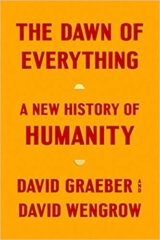
The Dawn of Everything: A New History of Humanity
For generations, our remote ancestors have been cast as primitive and childlike―either free and equal innocents, or thuggish and warlike. Civilization, we are told, could be achieved only by sacrificing those original freedoms or, alternatively, by taming our baser instincts. David Graeber and David Wengrow show how such theories first emerged in the eighteenth century as a conservative reaction to powerful critiques of European society posed by Indigenous observers and intellectuals. Revisiting this encounter has startling implications for how we make sense of human history today, including the origins of farming, property, cities, democracy, slavery, and civilization itself.
Drawing on pathbreaking research in archaeology and anthropology, the authors show how history becomes a far more interesting place once we learn to throw off our conceptual shackles and perceive what’s really there. If humans did not spend 95 percent of their evolutionary past in tiny bands of hunter-gatherers, what were they doing all that time? If agriculture, and cities, did not mean a plunge into hierarchy and domination, then what kinds of social and economic organization did they lead to? The answers are often unexpected, and suggest that the course of human history may be less set in stone, and more full of playful, hopeful possibilities, than we tend to assume.
The Dawn of Everything fundamentally transforms our understanding of the human past and offers a path toward imagining new forms of freedom, new ways of organizing society. This is a monumental book of formidable intellectual range, animated by curiosity, moral vision, and a faith in the power of direct action.

The Human Calling: Three Thousand Years of Eastern and Western Philosophical History
The Human Calling is a vigorously researched and profoundly spiritual narrative history of the world’s religious movements as they relate to society’s collective understanding of the duties they have to fellow people and looks ahead to what lessons from history can be applied as people navigate a technological age.
Focusing on the rise and fall of spiritual movements in both the East and West, The Human Calling examines what the world’s major religions have historically offered, asks what people are here for outside of pure survival, and makes the persuasive argument for Christianity as the best leader to guide individuals on the path toward better caring for one another—our human calling. The Human Calling takes readers through humanity’s three great thought movements:
The first is the Axial Age, the source of the first great human reflection on public spirit and public order
The second is the 12th-17th centuries, wrestles with the question of whether people can attain individual rationality in God’s order
The third delves into the independent reasoning societies of the 20thand 21st centuries and looks forward to what people want their third great reflection on God’s plan to be during their own period of societal flux
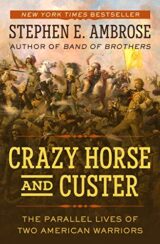
Crazy Horse and Custer: The Parallel Lives of Two American Warriors
On the sparkling morning of June 25, 1876, 611 men of the United States 7th Cavalry rode toward the banks of Little Bighorn in the Montana Territory, where three thousand Indians stood waiting for battle. The lives of two great warriors would soon be forever linked throughout history: Crazy Horse, leader of the Oglala Sioux, and General George Armstrong Custer. Both were men of aggression and supreme courage. Both became leaders in their societies at very early ages. Both were stripped of power, in disgrace, and worked to earn back the respect of their people. And to both of them, the unspoiled grandeur of the Great Plains of North America was an irresistible challenge. Their parallel lives would pave the way, in a manner unknown to either, for an inevitable clash between two nations fighting for possession of the open prairie.

Maniac: The Bath School Disaster and the Birth of the Modern Mass Killer
In 1927, while the majority of the township of Bath, Michigan, was celebrating a new primary school—one of the most modern in the Midwest—Andrew P. Kehoe had other plans. The local farmer and school board treasurer was educated, respected, and an accommodating neighbor and friend. But behind his ordinary demeanor was a narcissistic sadist seething with rage, resentment, and paranoia. On May 18 he detonated a set of rigged explosives with the sole purpose of destroying the school and everyone in it. Thirty-eight children and six adults were murdered that morning, culminating in the deadliest school massacre in US history.
Maniac is Harold Schechter’s gripping, definitive, exhaustively researched chronicle of a town forced to comprehend unprecedented carnage and the triggering of a “human time bomb” whose act of apocalyptic violence would foreshadow the terrors of the current age.
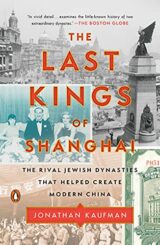
The Last Kings of Shanghai: The Rival Jewish Dynasties That Helped Create Modern China
Shanghai, 1936. The Cathay Hotel, located on the city’s famous waterfront, is one of the most glamorous in the world. Built by Victor Sassoon–billionaire playboy and scion of the Sassoon dynasty–the hotel hosts a who’s who of global celebrities: Noel Coward has written a draft of Private Lives in his suite and Charlie Chaplin has entertained his wife-to-be. And a few miles away, Mao and the nascent Communist Party have been plotting revolution.
By the 1930s, the Sassoons had been doing business in China for a century, rivaled in wealth and influence by only one other dynasty–the Kadoories. These two Jewish families, both originally from Baghdad, stood astride Chinese business and politics for more than 175 years, profiting from the Opium Wars; surviving Japanese occupation; courting Chiang Kai-shek; and losing nearly everything as the Communists swept into power. In The Last Kings of Shanghai, Jonathan Kaufman tells the remarkable history of how these families participated in an economic boom that opened China to the world, but remained blind to the country’s deep inequality and to the political turmoil at their doorsteps. In a story stretching from Baghdad to Hong Kong to Shanghai to London, Kaufman enters the lives and minds of these ambitious men and women to forge a tale of opium smuggling, family rivalry, political intrigue, and survival.
The book lays bare the moral compromises of the Kadoories and the Sassoons–and their exceptional foresight, success, and generosity. At the height of World War II, they joined together to rescue and protect eighteen thousand Jewish refugees fleeing Nazism. Though their stay in China started out as a business opportunity, the country became a home they were reluctant to leave, even on the eve of revolution. The lavish buildings they built and the booming businesses they nurtured continue to define Shanghai and Hong Kong to this day. As the United States confronts China’s rise, and China grapples with the pressures of brea
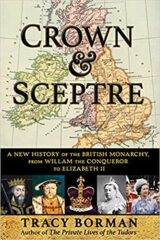
Crown & Sceptre: A New History of the British Monarchy, from William the Conqueror to Elizabeth II
Since William the Conqueror, duke of Normandy, crossed the English Channel in 1066 to defeat King Harold II and unite England’s various kingdoms, forty-one kings and queens have sat on Britain’s throne: “shining examples of royal power and majesty alongside a rogue’s gallery of weak, lazy, or evil monarchs,” as Tracy Borman evocatively describes them in her sparkling chronicle, Crown & Sceptre. Ironically, during very few of these 955 years has the throne’s occupant been unambiguously English―the Norman French, the Welsh-born Tudors, the Scottish Stuarts, and the Hanoverians and their German successors to the present day have dominated the throne.
Appealing to the intrinsic fascination with British royalty, Borman lifts the veil to reveal the remarkable characters and personalities who have ruled and, since the Glorious Revolution of 1688, have more ceremonially reigned―a crucial distinction explaining the staying power of the monarchy as the royal family has evolved and adapted to the needs and opinions of its people, avoiding the storms of rebellion that brought many of Europe’s royals to an abrupt end. Richard III; Henry VIII; Elizabeth I; George III; Victoria; Elizabeth II: their names evoke eras and dramatic events, forming the sweep of British history that Borman recounts. She is equally attuned to the fabric of monarchy: the impact of royal palaces; the way monarchs have been portrayed in art, on coins, in the media; the ceremony and pageantry surrounding the crown.
In 2024, Elizabeth II would eclipse France’s Louis XIV as the longest reigning monarch in history. Crown & Sceptre is a fitting tribute to her remarkable longevity and that of the magnificent institution she represents.

Their Finest Hour (Winston S. Churchill The Second World Wa Book 2)
In Their Finest Hour, Winston Churchill describes the invasion of France and a growing sense of dismay in Britain. Should Britain meet France’s desperate pleas for reinforcements or conserve their resources in preparation for the inevitable German assault? In the book’s second half, entitled simply “Alone,” Churchill discusses Great Britain’s position as the last stronghold against German conquest: the battle for control of the skies over Britain, diplomatic efforts to draw the United States into the war, and the spreading global conflict.
Their Finest Hour is part of the epic six-volume account of World War II told from the viewpoint of a man who led in the fight against tyranny, and enriched with extensive primary sources including memos, letters, orders, speeches, and telegrams, day-by-day accounts of reactions as the drama intensifies. Throughout these volumes, we listen as strategies and counterstrategies unfold in response to Hitler’s conquest of Europe, planned invasion of England, and assault on Russia, in a mesmerizing account of the crucial decisions made as the fate of the world hangs in the balance.

The Nineties: A Book
It was long ago, but not as long as it seems: The Berlin Wall fell and the Twin Towers collapsed. In between, one presidential election was allegedly decided by Ross Perot while another was plausibly decided by Ralph Nader. In the beginning, almost every name and address was listed in a phone book, and everyone answered their landlines because you didn’t know who it was. By the end, exposing someone’s address was an act of emotional violence, and nobody picked up their new cell phone if they didn’t know who it was. The 90s brought about a revolution in the human condition we’re still groping to understand. Happily, Chuck Klosterman is more than up to the job.
Beyond epiphenomena like “Cop Killer” and Titanic and Zima, there were wholesale shifts in how society was perceived: the rise of the internet, pre-9/11 politics, and the paradoxical belief that nothing was more humiliating than trying too hard. Pop culture accelerated without the aid of a machine that remembered everything, generating an odd comfort in never being certain about anything. On a 90’s Thursday night, more people watched any random episode of Seinfeld than the finale of Game of Thrones. But nobody thought that was important; if you missed it, you simply missed it. It was the last era that held to the idea of a true, hegemonic mainstream before it all began to fracture, whether you found a home in it or defined yourself against it.
In The Nineties, Chuck Klosterman makes a home in all of it: the film, the music, the sports, the TV, the politics, the changes regarding race and class and sexuality, the yin/yang of Oprah and Alan Greenspan. In perhaps no other book ever written would a sentence like, “The video for ‘Smells Like Teen Spirit’ was not more consequential than the reunification of Germany” make complete sense. Chuck Klosterman has written a multi-dimensional masterpiece, a work of synthesis so smart and delightful that future historians might well refer to this entire period as Klosterm

Empire of the Summer Moon
In the tradition of “Bury My Heart at Wounded Knee”, a stunningly vivid historical account of the forty-year battle between Comanche Indians and white settlers for control of the American West, centering on Quanah, the greatest Comanche chief of them all, “Empire of the Summer Moon” spans two astonishing stories. The first traces the rise and fall of the Comanches, the most powerful Indian tribe in American history. The second is the epic saga of the pioneer woman Cynthia Ann Parker and her mixed-blood son Quanah, who became the last and greatest chief of the Comanches. Although readers may be more familiar with the tribal names Apache and Sioux, it was in fact the legendary fighting ability of the Comanches that determined just how and when the American West opened up. Comanche boys became adept bareback riders by age six; full Comanche braves were considered the best horsemen who ever rode. They were so masterful at war and so skillful with their arrows and lances that they stopped the northern drive of colonial Spain from Mexico and halted the French expansion westward from Louisiana. White settlers arriving in Texas from the eastern United States were surprised to find the frontier being rolled backward by Comanches incensed by the invasion of their tribal lands. Against this backdrop Gwynne presents the compelling drama of Cynthia Ann Parker, a nine-year-old girl who was kidnapped by Comanches in 1836. She grew to love her captors and became infamous as the ‘White Squaw’ who refused to return until her tragic capture by Texas Rangers in 1860. More famous still was her son Quanah, a warrior who was never defeated and whose guerrilla wars in the Texas Panhandle made him a legend. S.C. Gwynne’s account of these events is meticulously researched, intellectually provocative, and, above all, thrillingly told.

The Girl and the Bombardier: A True Story of Resistance and Rescue in Nazi-Occupied France
Susan Tate Ankeny’s father was a World War II veteran bombardier who had bailed from a burning B-17 over Nazi-occupied France in 1944. After he died, she found his unfinished memoir, stacks of envelopes, black-and-white photographs, mission reports, dog tags, and the fake identity cards he used in his escape. Ankeny spent more than a decade tracking down letter writers, their loved ones, and anyone who had played a role in her father’s story, culminating in a trip to France where she retraced his path with the same people who had guided him more than sixty years ago.
While piecing together her father’s wartime experience, Ankeny discovered a remarkable hero. Godelieve Van Laere was just a teenaged girl when she saved the fallen Lieutenant Dean Tate, risking her life and forging a friendship that would last into a new century.
The result is a fascinating and dramatic World War II tale enhanced by personal interviews with participants. It traces the transformation of a small-town American boy into a bombardier, the thrill and chaos of aerial warfare, and the horror of bailing from a flaming aircraft over enemy territory. It distinguishes the actions of a little-known French resistance network for Allied airmen known as Shelburne. And it shines a light on the courage and cunning of a young woman who risked her life to save another.
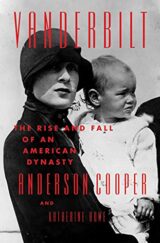
Vanderbilt: The Rise and Fall of an American Dynasty
When eleven-year-old Cornelius Vanderbilt began to work on his father’s small boat ferrying supplies in New York Harbor at the beginning of the nineteenth century, no one could have imagined that one day he would, through ruthlessness, cunning, and a pathological desire for money, build two empires—one in shipping and another in railroads—that would make him the richest man in America. His staggering fortune was fought over by his heirs after his death in 1877, sowing familial discord that would never fully heal. Though his son Billy doubled the money left by “the Commodore,” subsequent generations competed to find new and ever more extraordinary ways of spending it. By 2018, when the last Vanderbilt was forced out of The Breakers—the seventy-room summer estate in Newport, Rhode Island, that Cornelius’s grandson and namesake had built—the family would have been unrecognizable to the tycoon who started it all.
Now, the Commodore’s great-great-great-grandson Anderson Cooper, joins with historian Katherine Howe to explore the story of his legendary family and their outsized influence. Cooper and Howe breathe life into the ancestors who built the family’s empire, basked in the Commodore’s wealth, hosted lavish galas, and became synonymous with unfettered American capitalism and high society. Moving from the hardscrabble wharves of old Manhattan to the lavish drawing rooms of Gilded Age Fifth Avenue, from the ornate summer palaces of Newport to the courts of Europe, and all the way to modern-day New York, Cooper and Howe wryly recount the triumphs and tragedies of an American dynasty unlike any other.
Written with a unique insider’s viewpoint, this is a rollicking, quintessentially American history as remarkable as the family it so vividly captures.
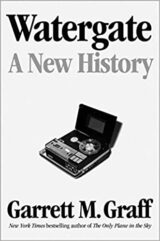
Watergate: A New History
In the early hours of June 17, 1972, a security guard named Frank Wills entered six words into the log book of the Watergate office complex that would change the course of history: 1:47 AM Found tape on doors; call police.
The subsequent arrests of five men seeking to bug and burgle the Democratic National Committee offices quickly unravels a web of scandal that ultimately ends a presidency and forever alters views of moral authority and leadership. Watergate, as the event is called, becomes a shorthand for corruption, deceit, and unanswered questions.
Now, award-winning journalist and bestselling author Garrett M. Graff explores the full scope of this unprecedented moment from start to finish, in Watergate: A New History, the first single-volume account in decades.
It begins in 1971, with the publication of thousands of military and government documents known as the Pentagon Papers, which reveal dishonesty about the decades-long American presence in Vietnam and spark public outrage. Furious that the leak might expose his administration’s own duplicity during a crucial reelection season, President Richard M. Nixon gathers his closest advisors and gives them implicit instructions: Win by any means necessary.
Within a few months, an unsteady line of political dominoes are positioned, from the creation of a series of covert operations code-named GEMSTONE to campaign-trail dirty tricks, possible hostage situations, and questionable fundraising efforts—much of it caught on the White House’s own taping system. One by one they fall, until the thwarted June burglary attracts the attention of journalists, investigators, and intelligence officers, one of whom will spend decades concealing his identity behind the alias “Deep Throat.” As each faction slowly begins to uncover the truth, a conspiracy deeper and more corrupt than anyone thought possible emerges, and the nation is thrown into a state of crisis as its government—and its leader—unravels.
Using newly public docum

The Secret Rescue: An Untold Story of American Nurses and Medics Behind Nazi Lines
A Wall Street Journal Bestseller
An Edgar Award Finalist and Anthony Award Finalist for Best Critical or Non-Fiction Work
When twenty-six Army nurses and medics—part of the 807th Medical Air Evacuation Transport Squadron—boarded a cargo plane for transport in November 1943, they never anticipated the crash landing in Nazi-occupied Albania that would lead to a months-long struggle for survival. In a drama that captured the attention of the American public, the group and its flight crew dodged bullets and battled blinding winter storms as they climbed mountains and fought to stay alive, aided by courageous villagers who risked death at Nazi hands to help them.
A mesmerizing tale of the heroism of ordinary people, The Secret Rescue tells a story of endurance kept secret for decades, and of the daring rescue attempts by clandestine American and British organizations amid the tumultuous landscape of the war.
“Combines all of the elements that draw us to WWII stories: the daring of The Guns of Navarone, the suspense of The Great Escape, and the bravery reminiscent of Ill Met by Moonlight. It’s the inclusion of so many women, though, that makes this story unique.” —The Daily Beast
“An amazing WWII survival-and-rescue story.” —Booklist
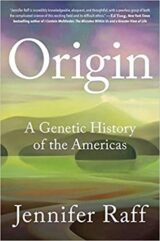
Origin: A Genetic History of the Americas
ORIGIN is the story of who the first peoples in the Americas were, how and why they made the crossing, how they dispersed south, and how they lived based on a new and powerful kind of evidence: their complete genomes. ORIGIN provides an overview of these new histories throughout North and South America, and a glimpse into how the tools of genetics reveal details about human history and evolution.
20,000 years ago, people crossed a great land bridge from Siberia into Western Alaska and then dispersed southward into what is now called the Americas. Until we venture out to other worlds, this remains the last time our species has populated an entirely new place, and this event has been a subject of deep fascination and controversy. No written records—and scant archaeological evidence—exist to tell us what happened or how it took place. Many different models have been proposed to explain how the Americas were peopled and what happened in the thousands of years that followed. A study of both past and present, ORIGIN explores how genetics is currently being used to construct narratives that profoundly impact Indigenous peoples of the Americas. It serves as a primer for anyone interested in how genetics has become entangled with identity in the way that society addresses the question “Who is indigenous?”
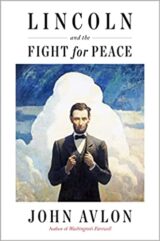
Lincoln and the Fight for Peace
As the tide of the Civil War turned in the spring of 1865, Abraham Lincoln took a dangerous two-week trip to visit the troops on the front lines accompanied by his young son, seeing combat up close, meeting liberated slaves in the ruins of Richmond, and comforting wounded Union and Confederate soldiers.
The power of Lincoln’s personal example in the closing days of the war offers a portrait of a peacemaker. He did not demonize people he disagreed with. He used humor, logic, and scripture to depolarize bitter debates. Balancing moral courage with moderation, Lincoln believed that decency could be the most practical form of politics, but he understood that people were more inclined to listen to reason when greeted from a position of strength. Ulysses S. Grant’s famously generous terms of surrender to General Robert E. Lee at Appomattox that April were a direct expression of the president’s belief that a soft peace should follow a hard war.
While his assassination sent the country careening off course, Lincoln’s vision would be vindicated long after his death, inspiring future generations in their own quests to secure a just and lasting peace. As US General Lucius Clay, architect of the post-WWII German occupation, said when asked what guided his decisions: “I tried to think of the kind of occupation the South would have had if Abraham Lincoln had lived.”
Lincoln and the Fight for Peace reveals how Lincoln’s character informed his commitment to unconditional surrender followed by a magnanimous peace. Even during the Civil War, surrounded by reactionaries and radicals, he refused to back down from his belief that there is more that unites us than divides us. But he also understood that peace needs to be waged with as much intensity as war. Lincoln’s plan to win the peace is his unfinished symphony, but in its existing notes, we can find an anthem that can begin to bridge our divisions today.

Defining Moments in Black History: Reading Between the Lies
With his trademark acerbic wit, incisive humor, and infectious paranoia, one of our foremost comedians and most politically engaged civil rights activists looks back at 100 key events from the complicated history of black America.
A friend of luminaries including Dr. Martin Luther King, Jr. and Medgar Evers, and the forebear of today’s popular black comics, including Larry Wilmore, W. Kamau Bell, Damon Young, and Trevor Noah, Dick Gregory was a provocative and incisive cultural force for more than fifty years. As an entertainer, he always kept it indisputably real about race issues in America, fearlessly lacing laughter with hard truths. As a leading activist against injustice, he marched at Selma during the Civil Rights movement, organized student rallies to protest the Vietnam War; sat in at rallies for Native American and feminist rights; fought apartheid in South Africa; and participated in hunger strikes in support of Black Lives Matter.
In this collection of thoughtful, provocative essays, Gregory charts the complex and often obscured history of the African American experience. In his unapologetically candid voice, he moves from African ancestry and surviving the Middle Passage to the enjoyment of bacon and everything pig, the headline-making shootings of black men, and the Black Lives Matter movement. A captivating journey through time, Defining Moments in Black History explores historical movements such as The Great Migration and the Harlem Renaissance, as well as cultural touchstones such as Sidney Poitier winning the Best Actor Oscar for Lilies in the Field and Billie Holiday releasing Strange Fruit.
An engaging look at black life that offers insightful commentary on the intricate history of the African American people, Defining Moments in Black History is an essential, no-holds-bar history lesson that will provoke, enlighten, and entertain.

Madhouse at the End of the Earth: The Belgica’s Journey into the Dark Antarctic Night
In August 1897, the young Belgian commandant Adrien de Gerlache set sail for a three-year expedition aboard the good ship Belgica with dreams of glory. His destination was the uncharted end of the earth: the icy continent of Antarctica.
But de Gerlache’s plans to be first to the magnetic South Pole would swiftly go awry. After a series of costly setbacks, the commandant faced two bad options: turn back in defeat and spare his men the devastating Antarctic winter, or recklessly chase fame by sailing deeper into the freezing waters. De Gerlache sailed on, and soon the Belgica was stuck fast in the icy hold of the Bellingshausen Sea. When the sun set on the magnificent polar landscape one last time, the ship’s occupants were condemned to months of endless night. In the darkness, plagued by a mysterious illness and besieged by monotony, they descended into madness.
In Madhouse at the End of the Earth, Julian Sancton unfolds an epic story of adventure and horror for the ages. As the Belgica’s men teetered on the brink, de Gerlache relied increasingly on two young officers whose friendship had blossomed in captivity: the expedition’s lone American, Dr. Frederick Cook—half genius, half con man—whose later infamy would overshadow his brilliance on the Belgica; and the ship’s first mate, soon-to-be legendary Roald Amundsen, even in his youth the storybook picture of a sailor. Together, they would plan a last-ditch, nearly certain-to-fail escape from the ice—one that would either etch their names in history or doom them to a terrible fate at the ocean’s bottom.
Drawing on the diaries and journals of the Belgica’s crew and with exclusive access to the ship’s logbook, Sancton brings novelistic flair to a story of human extremes, one so remarkable that even today NASA studies it for research on isolation for future missions to Mars. Equal parts maritime thriller and gothic horror, Madhouse at the End of the Earth is an unforgettable journey into the deep.

